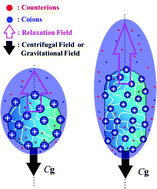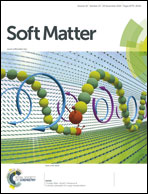Influence of polyelectrolyte shape on its sedimentation behavior: effect of relaxation electric field†
Abstract
The sedimentation of an isolated, charged polyelectrolyte (PE) subjected to an applied field is modeled theoretically, taking into account the variation of its shape. In particular, the effects of double-layer relaxation, effective charge density, and strength of the induced relaxation electric field are examined. We show that the interaction of these effects yields complex and interesting sedimentation behaviors. For example, the behavior of the electric force acting on a loosely structured PE can be different from that on a compactly structured one; the former is dominated mainly by the convective fluid flow. For thick double layers, electric force has a local maximum as the Reynolds number varies, but tends to increase monotonically with increasing Reynolds number if the layer is thin. The drag factor is found to behave differently from literature results. The shape of a PE significantly influences its sedimentation behavior by affecting the amount of counterions attracted to its interior and the associated local electric field. Interestingly, a more stretched PE has a higher effective charge density but experiences a weaker electric force.


 Please wait while we load your content...
Please wait while we load your content...